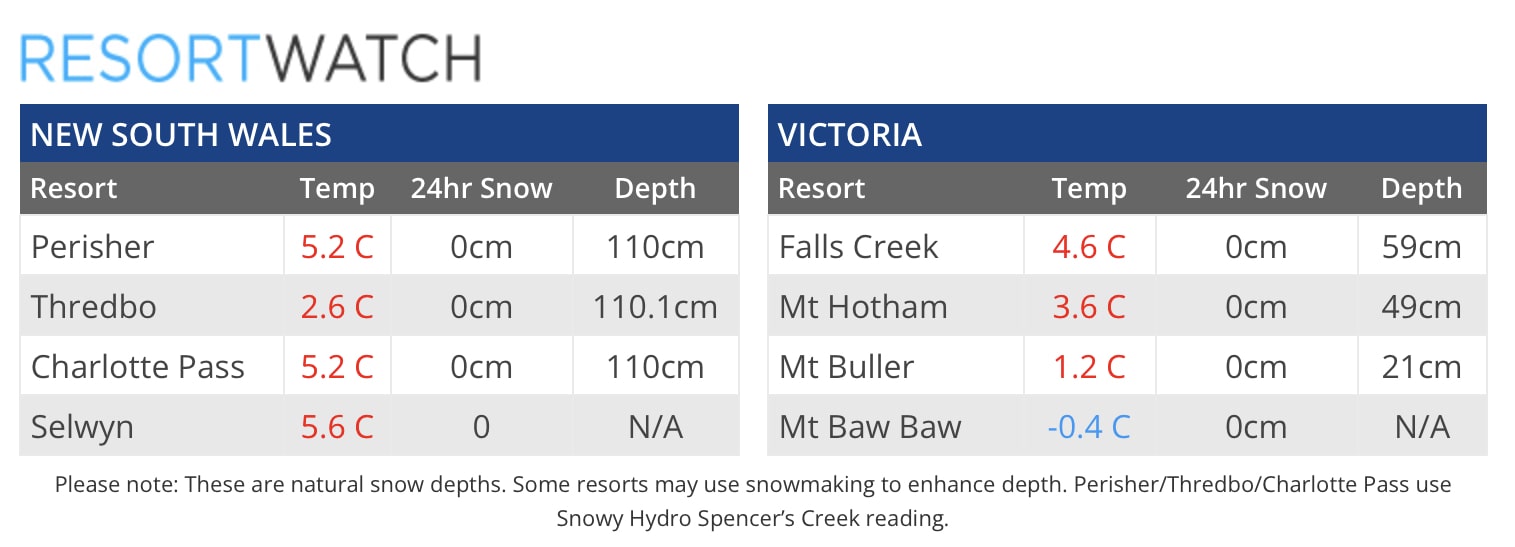
It is August and usually this means it is the best month to head out to ski or snowboard downunder. Unfortunately Australia has been hit by a high pressure front, that has kept resorts above freezing temperatures for a whole week. The sunshine combined with the spring-like temperatures melted significant amounts of the snow cover and above freezing temperatures did not allow for any snow making over night last week.
According to the Australian Bureau of Meteorology (‘BOM’), Australia’s national mean temperature was 1.19°C above the 1961-1990 average, the ninth-highest on record (since 1910) for July. While nationally-averaged July total rainfall for Australia was close to average, rainfall for Victoria, where some of the ski resorts are located, was below average.
A number of fronts crossed southern Australia during July bringing some snow to the skifields and clear skies and light winds in early July resulted in cold nights, enabling sufficient snow making. However, in the last five days of July mild daytime temperatures across Australia resulted in daily maximum temperatures 2 to 8 °C above the July average and resulted in an erosion of the snow cover across Australian ski resorts.

Australia had seen good snow fall in late June and snowfalls were tracking well against recent El Niño years, like 2016 and 2006, but the last week has put a huge dent in the snow fun for now and once can only hope that the next cold front will come soon and bring some precipitation in the form of snow with it.

Perisher Ski Resort and Thredbo Ski Resort are both still counting 110cm (43 inches) of natural snow depth at this point. However, the sun has eroded many exposed areas, resulting in limited operations in some areas.
Perisher announced today that its ski area Guthega will be closed for skiing. Blue Calf and Blue Cow t-bar will operate for access to Blue Cow area only.
Skiing or boarding will not be possible from Perisher to Blue Cow, however Copperhead Road, which gives access in the opposite direction, is still accessible.

There is also no on-snow access to Smiggin Holes. A shuttle will be operating between Smiggins and Perisher instead. Smiggins, which is a popular beginner area and lowest in altitude in the combined Perisher Ski Resort, is only operating one t-bar and two j-bars as well as its two beginner conveyors today.

Selwyn Snow Resort has been closed since last Monday. The resort is Australia’s most northern ski resort and is located at an altitude of 1,492 m (4,895 ft) and reaches a top elevation of 1,614 ft (5,295 ft). In the southern hemisphere, a northern location of course means closer to the equator and thus warmer, which means the resort can have trouble maintaining a good natural snow cover. The resort invested heavily into snowmaking infrastructure after the 2019/20 bushfires, purchasing state-of-the-art TechnoAlpin snow cannons, but recently temperatures have stayed above freezing and day time temperatures were around 10°C (50°F).

Over the state line in Victoria, resorts are struggling the same. Mt Hotham reportedly has a natural snow depth of 49cm (19 inches) while Falls Creek has around 59cm (23 inches) . Mt Buller, which is located at a lower altitude than the aforementioned resorts, currently only has 21cm (8 inches) of natural snow depth on average across the resort. Some ski runs are entirely devoid of snow.

Thankfully temperatures are forecast to drop which should enable natural snow making. There is some snowfall forecast in 10-14 days, but weather models that far out tend to be highly unreliable.
All we can doe downunder is hope that a cold front will change things this August and do a little snow dance or two. It is only early August and late August and September can often still see significant snowfalls.
